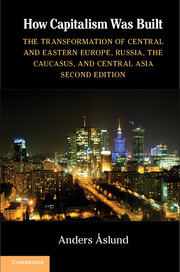 How Capitalism Was Built
How Capitalism Was Built Book contents
- Frontmatter
- Contents
- List of Tables and Figures
- Acknowledgments
- List of Abbreviations
- Introduction
- 1 Communism and Its Demise
- 2 Radical Reform versus Gradualism
- 3 Output
- 4 Liberalization
- 5 From Hyperinflation to Financial Stability
- 6 Privatization
- 7 The Social System
- 8 The Politics of Transition
- 9 From Crime Toward Law
- 10 The Importance of the European Union
- 11 The Global Financial Crisis, 2007–2012
- 12 Conclusions
- Bibliography
- Index
11 - The Global Financial Crisis, 2007–2012
Published online by Cambridge University Press: 05 December 2012
- Frontmatter
- Contents
- List of Tables and Figures
- Acknowledgments
- List of Abbreviations
- Introduction
- 1 Communism and Its Demise
- 2 Radical Reform versus Gradualism
- 3 Output
- 4 Liberalization
- 5 From Hyperinflation to Financial Stability
- 6 Privatization
- 7 The Social System
- 8 The Politics of Transition
- 9 From Crime Toward Law
- 10 The Importance of the European Union
- 11 The Global Financial Crisis, 2007–2012
- 12 Conclusions
- Bibliography
- Index
Summary
From 2000 until 2008, the whole postcommunist world was doing extremely well economically. However, in 2006, financial warning bells started ringing. Many postcommunist countries had large current-account deficits, massive credit expansion, and rising inflation, and some had accumulated large foreign debt. This could not go on, as many, including the International Monetary Fund (IMF), stated (Goldstein 2007; Schadler 2008). The concerns were greatest where economic virtues had excelled, in the Baltics and Kazakhstan. Central and Eastern Europe seemed more exposed than the post-Soviet countries.
Rationally, capital had flown to areas offering higher return on investment in efficient, fast-growing new Europe from inefficient, overtaxed, slow-growing, bureaucratized old Europe. Central and Eastern Europe was enjoying far higher growth rates than the old European Union-15 (EU-15), benefiting from catch-up growth in relation to the still-richer, old EU countries. The postcommunist countries had lower taxes, fewer social transfers, and more flexible labor markets. Modern neoclassical growth theory taught that with similar open-market economies, gross domestic product (GDP) levels would converge over time, leading to the obvious conclusion that European economic convergence was the natural outcome (Barro and Sala-i-Martin 2004), and for nearly two decades, economic convergence had been palpable (Balcerowicz and Fischer 2006).
- Type
- Chapter
- Information
- How Capitalism Was BuiltThe Transformation of Central and Eastern Europe, Russia, the Caucasus, and Central Asia, pp. 326 - 357Publisher: Cambridge University PressPrint publication year: 2012


